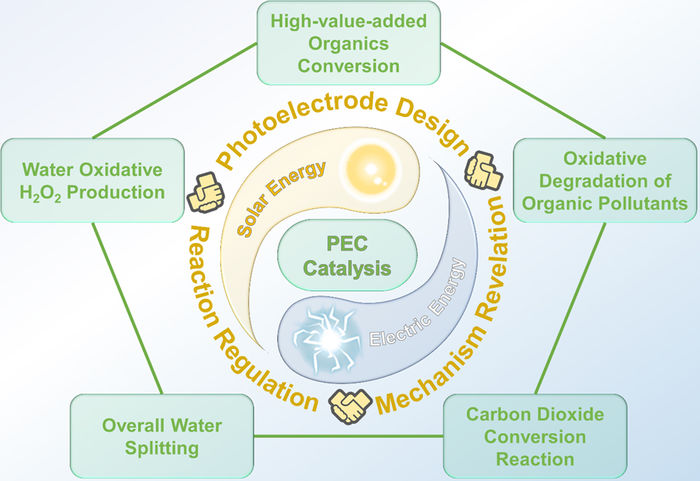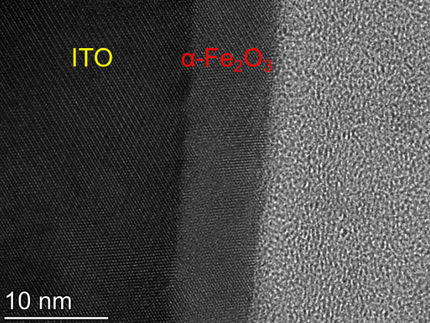Photoelectrocatalysis for high-value-added chemicals production
Solar-to-chemical energy conversion using photoelectrochemical (PEC) technology is a promising route to achieve carbon neutralization
The development and application of solar energy has attained extensive attention along with the aggravating global energy crisis due to its large resource reserves, wide distribution and environment friendly. photoelectrocatalysis (PEC) has been regarded as a promising approach to transform solar energy and stored in the form of chemical energy. In recent years, water splitting has become the main application direction of PEC technology because of the security and simplicity of this reaction, and the hydrogen produced by the cathodic reaction. However, the anodic oxygen evolution reaction (OER) in PEC water splitting is a four-electron process with sluggish kinetics, leading to a poor efficiency of the system. Additionally, the O2 generated by OER has inferior economic value, which is not beneficial to reduce the overall cost of water splitting. Therefore, the design of efficient photoelectrode combined with the research for suitable OER alternative reaction are the critical issues to extending PEC technology to practical application.

Solar-to-chemical energy conversion using photoelectrochemical (PEC) technology is a promising route to achieve carbon neutralization. The researchers give a detailed summary and discussion of the PEC reaction system, including common PEC water splitting systems and high-value-added chemicals production systems such as hydrogen peroxide production, organic wastewater treatment, selective conversion of organic raw materials and carbon dioxide reduction.
Chinese Journal of Catalysis
Actually, there are various reactions that can be performed in the PEC system except for water splitting, such as H2O oxidative H2O2 synthesis reaction, organic oxidation reaction and CO2 reduction reaction (CO2RR). These reactions are all means to add value to chemicals to achieve high-value-added chemical production. For example, O2 obtained through OER is a common and budget chemical that is similar to its raw material of H2O, which can be replaced by photoelectrooxidation of H2O to high-value-added H2O2. Furthermore, as a low-cost biomass organic chemical, glycerol can be converted into more valuable chemicals such as 1,3-dihydroxyacetone and glyceraldehyde through an oxidation process. Moreover, this type of reaction requires a lower reaction potential in comparison OER, which means that the system can input less energy to get more products. As for photocathode, there are also many studies focus on the CO2RR, which play a dual purpose of converting solar energy into high-value-added chemicals (such as carbon monoxide, formate, methanol, and ethanol) and reducing anthropogenic CO2 levels.
To realize the above processes, the primary problem that must be solved is the matching of semiconductor materials and alternative reactions, such as the energy band position of the semiconductor must be appropriate to drive the reaction smoothly. In addition to screening materials, the selectivity of photoelectrodes for high-value-added products needs to be regulated. Therefore, it is a huge challenge to design a system with satisfactory performance photoelectrode that meets these requirements. Although some design methods of water splitting systems have been reviewed, there is no comprehensive discussion on the production of various high-value-added products in PEC systems.
Recently, a research team led by Prof. Mingfei Shao from Beijing University of Chemical Technology, China reported an Account that discusses the use of PEC technology to produce various high-value-added products and environmental treatment applications, where several PEC systems are discussed, including PEC water splitting, PEC organic oxidation coupled with hydrogen evolution, and PEC carbon dioxide reduction reaction. Based on the opinion of regulating the photoelectrode to match the production reaction of high-value-added chemicals and ensuring selectivity is the core of this field, the development of future PEC systems is also prospected.
Original publication
Other news from the department science

Get the chemical industry in your inbox
By submitting this form you agree that LUMITOS AG will send you the newsletter(s) selected above by email. Your data will not be passed on to third parties. Your data will be stored and processed in accordance with our data protection regulations. LUMITOS may contact you by email for the purpose of advertising or market and opinion surveys. You can revoke your consent at any time without giving reasons to LUMITOS AG, Ernst-Augustin-Str. 2, 12489 Berlin, Germany or by e-mail at revoke@lumitos.com with effect for the future. In addition, each email contains a link to unsubscribe from the corresponding newsletter.



























































